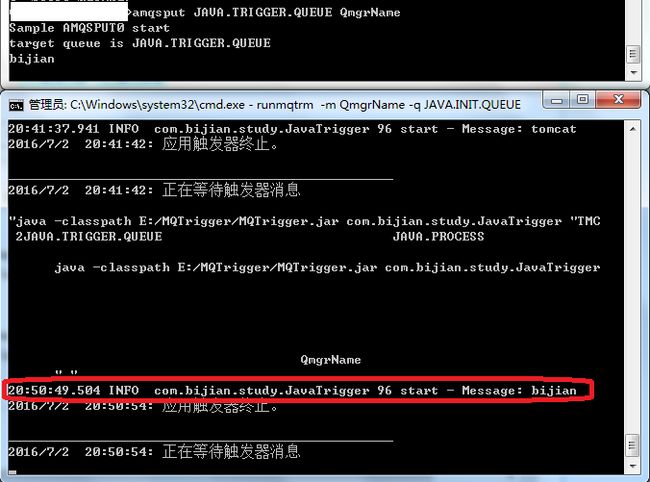WebSphere MQ的配置请参考配置IBM WEBSPHERE MQ触发器中的方法二,唯一要改的是定义进程,定义进程改为如下:
DEFINE PROCESS('JAVA.PROCESS') REPLACE +
DESCR('Process to test triggering') +
APPLICID('java -classpath E:/MQTrigger/MQTrigger.jar com.bijian.study.JavaTrigger')
由java -classpath E:/MQTrigger/MQTrigger.jar com.bijian.study.JavaTrigger可知,我将如下工程代码导出为MQTrigger.jar放到了E盘的MQTrigger目录下。
JavaTrigger.java
package com.bijian.study;
import java.io.IOException;
import com.ibm.mq.MQC;
import com.ibm.mq.MQException;
import com.ibm.mq.MQGetMessageOptions;
import com.ibm.mq.MQMessage;
import com.ibm.mq.MQQueue;
import com.ibm.mq.MQQueueManager;
import org.apache.logging.log4j.LogManager;
import org.apache.logging.log4j.Logger;
public class JavaTrigger {
private static Logger logger = LogManager.getLogger(JavaTrigger.class.getName());
private MQQueueManager qMgr;
public static void main(String args[]) throws IOException {
if (args.length < 1) {
logger.info("This must be a triggered application");
} else {
JavaTrigger jt = new JavaTrigger();
jt.start(args);
}
System.exit(0);
}
public void start(String args[]) {
try {
MQException.log = null;
/******************************************************/
/* Create a MQTrigger class object to read the MQTMC2 */
/* structure into the correct attribute. */
/******************************************************/
MQTrigger tmc = new MQTrigger(args[0]);
/******************************************************/
/* Connect to the queue manager identified by the */
/* trigger. */
/******************************************************/
qMgr = new MQQueueManager(tmc.getQueueManagerName());
/******************************************************/
/* Open the queue identified by the trigger. */
/******************************************************/
int openOptions = MQC.MQOO_INPUT_AS_Q_DEF | MQC.MQOO_FAIL_IF_QUIESCING;
MQQueue triggerQueue = qMgr.accessQueue(tmc.getQueueName(), openOptions, null, null, null);
/******************************************************/
/* Set up our options to get the first message */
/* Wait 5 seconds to be cetain all messages are */
/* processed. */
/******************************************************/
MQGetMessageOptions gmo = new MQGetMessageOptions();
gmo.options = MQC.MQGMO_WAIT | MQC.MQGMO_CONVERT;
gmo.waitInterval = 5000;
MQMessage triggerMessage = new MQMessage();
/*****************************************************/
/* Read each message from the queue until there are */
/* no more messages to get. */
/*****************************************************/
long rc = 0;
do {
rc = 0;
try {
/***********************************************/
/* Set the messageId and correlationId to none */
/* to get all messages with no message */
/* selection. */
/***********************************************/
triggerMessage.clearMessage();
triggerMessage.correlationId = MQC.MQCI_NONE;
triggerMessage.messageId = MQC.MQMI_NONE;
triggerQueue.get(triggerMessage, gmo);
String msg = triggerMessage.readString(triggerMessage.getMessageLength());
/***********************************************/
/* Insert business logic for the message here. */
/* For this sample, echo the first 20 */
/* characters of the message. */
/***********************************************/
if (msg.length() > 20) {
logger.info("Message: " + msg.substring(0, 20));
} else {
logger.info("Message: " + msg);
}
} catch (MQException mqEx) {
rc = mqEx.reasonCode;
if (rc != MQException.MQRC_NO_MSG_AVAILABLE) {
logger.info(" PUT Message failed with rc = " + rc);
}
} catch (Exception ex) {
logger.info("Generic exception: " + ex);
rc = 1;
}
} while (rc == 0);
/**********************************************************/
/* Cleanup MQ resources prior to exiting. */
/**********************************************************/
triggerQueue.close();
qMgr.disconnect();
}
catch (MQException mqEx) {
logger.info("MQ failed with completion code = " + mqEx.completionCode + " and reason code = "
+ mqEx.reasonCode);
}
}
}
MQTrigger.java
package com.bijian.study;
class MQTrigger {
private String structId;
private String version;
private String qName;
private String processName;
private String triggerData;
private String applType;
private String applId;
private String envData;
private String userData;
private String qMgrName;
/******************************************************/
/* Constructor to parse the MQTMC2 stucture and set */
/* the class attributes. */
/* Values derived from field definitions given for */
/* MQTMC2 in the WebSphere Application Programming */
/* Reference. */
/******************************************************/
public MQTrigger(String tmcStruct) throws StringIndexOutOfBoundsException {
structId = tmcStruct.substring(0, 3).trim();
version = tmcStruct.substring(4, 8).trim();
qName = tmcStruct.substring(8, 55).trim();
processName = tmcStruct.substring(56, 103).trim();
triggerData = tmcStruct.substring(104, 167).trim();
applType = tmcStruct.substring(168, 171).trim();
applId = tmcStruct.substring(172, 427).trim();
envData = tmcStruct.substring(428, 555).trim();
userData = tmcStruct.substring(556, 683).trim();
qMgrName = tmcStruct.substring(684, 730).trim();
}
public String getStructId() {
return (structId);
}
public String getVersion() {
return (version);
}
public String getQueueName() {
return (qName);
}
public String getProcessName() {
return (processName);
}
public String getTriggerData() {
return (triggerData);
}
public String getApplicationType() {
return (applType);
}
public String getApplicationId() {
return (applId);
}
public String getEnvironmentData() {
return (envData);
}
public String getUserData() {
return (userData);
}
public String getQueueManagerName() {
return (qMgrName);
}
}
运行效果:
参考文章:http://www.cnblogs.com/windows/archive/2012/09/25/2701613.html
